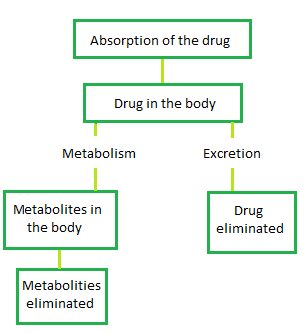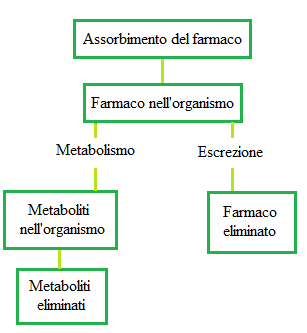Introduction to Pharmacology [ENG/ITA]
.jpg)
Any chemical substance, synthetic or natural, extraneous to the organism or derived from it, used to treat, prevent or diagnose a disease.
and also:
Any substance that can change a biological function.
The process of elimination is distinguished in metabolism, when the drug is "transformed" into another molecule, while the excretion consists in its expulsion without having been altered, or without having undergone any modification.

This is easily obtainable for those drugs that have the site of action outside the body, such as on the skin or on the mucosa of the digestive or respiratory tract (the latter as they are in direct communication with the external environment).
If, instead, the site of action of the drug is inside the organism, it will depend on the speed with which it is absorbed, distributed, metabolized and excreted, and must be able to overcome a series of organic "barriers", like the skin or the intestinal epithelium.
The main barrier taken into consideration is the cell membrane, obviously not all drugs will penetrate with the same speed and with the same mechanism, this feature will depend on the molecular size, the degree of ionization and the partition coefficient (the degree of solubility in water or oil) of the drug molecule.
Bibliography:
- Goodman and Gilman - "Il Manuale - Le Basi Farmacologiche della Terapia" - Zanichelli Editore (2015)
- Paola Dorigo - "Farmacologia Generale" - CEDAM (2006)
Qualsiasi sostanza chimica, sintetica o naturale, estranea all’organismo o da essa derivata, utilizzata per curare, prevenire o diagnosticare una malattia.
e anche:
Qualsiasi sostanza in grado di modificare una funzione biologica.

La dose di farmaco da somministrare è un parametro fondamentale per l’efficacia della terapia ed è un dato inscindibile dallo studio della distribuzione e del metabolismo che subisce il farmaco una volta che viene assunto.
La dose, infatti, è indispensabile per l’ottenimento dell’effetto terapeutico, una dose inferiore al necessario, non permette l’ottenimento di una concentrazione utile per raggiungere il sito d’azione del farmaco; mentre, una dose eccessiva, potrebbe comportare fenomeni di accumulo all’interno dell’organismo della molecola, oppure ad effetti tossici, che in alcuni casi possono essere letali.
Soggetti diversi avranno risposte diverse alla stessa dose dello stesso farmaco. Questo è determinato dal fatto che ognuno di noi possiede degli enzimi prodotti da uno specifico gene, che ci permette di metabolizzare la sostanza, ma questi geni sono polimorfici, ovvero nella popolazione esistono delle varianti che portano alla produzione di enzimi con capacità diverse di metabolizzazione, provocando il diverso metabolismo e tossicità negli individui di un farmaco. Oltre agli enzimi, possono esistere anche differenze nel bersaglio del farmaco e nel legame che formano.
Come detto precedentemente, per ottenere l’effetto terapeutico è necessario che vi sia presente un’appropriata concentrazione di farmaco nella sua sede d’azione.
Questo è facilmente ottenibile per quei farmaci che hanno il sito d’azione all’esterno dell’organismo, come sulla cute o sulla mucosa dell’apparato digerente o respiratorio (questi ultimi in quanto sono in comunicazione diretta con l’ambiente esterno).
Se invece, la sede d’azione del farmaco si trova all’interno dell’organismo, esso dipenderà dalla velocità con cui esso viene assorbito, distribuito, metabolizzato ed escreto, e dovrà essere in grado di superare una serie di “barriere” organiche, come la cute o l’epitelio intestinale.
La principale barriera presa in considerazione è la membrana cellulare, ovviamente non tutti i farmaci vi penetreranno con la stessa velocità e con lo stesso meccanismo, questa caratteristica dipenderà dalle dimensioni molecolari, dal grado di ionizzazione e dal coefficiente di ripartizione (il grado di solubilità in acqua o olio) della molecola di farmaco.
Bibliography:
- Goodman and Gilman - "Il Manuale - Le Basi Farmacologiche della Terapia" - Zanichelli Editore (2015)
- Paola Dorigo - "Farmacologia Generale" - CEDAM (2006)


Being A SteemStem Member
Very good your post. It's good to see these contents here. I studied a lot for Goodman and Gilman, and it's our pharmacology reference here in Brazil as well. A reading that is not easy, so first read Katzung. And then read Goodman. Congratulations on the post!
Thank you very much. I know ..the Goodman is hard. When I was at university I studied on both books, but for my exams I used the Goodman-Gilman, because it focuses more on the mechanisms of action.
My intention is to continue writing about these topics, for now in general, and later specifically on some classes of drugs.
Letto volentieri e visto che in questo momento sono imbottito di medicine per via di una cervicale... diciamo che assimilo meglio i principi attivi 😁😁😁
Un saluto, nicola
Mi dispiace per la cervicale, spero abbiano fatto effetto e tu stia meglio!
Your work is encouraging.
Kindly produce more of this as it will help to boost Steemit's scientific library.
More scientific materials of an educational nature are required.
Thank you for your appreciation and support. I will certainly continue to write about these topics.